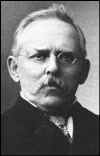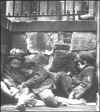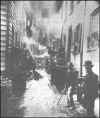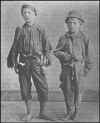|
notes
|
RIIS' PEACE
Five residents reflect on 50 years of
life in the New York City Housing Authority's Jacob Riis Houses.
By Annia Ciezadlo
The 19 red-brick towers of the Jacob Riis
Houses lining Avenue D look much as they did when they opened in 1949.
Many families have come and gone in the 1,768 apartments, but 13 of the
original families are still there.
Immediately after World War II, returning
GIs and soaring construction costs created a housing shortage, and NYCHA
gave preference to the veterans. When Jacob Riis Houses opened, the
tenants reflected both the racial composition of the surrounding
neighborhood--white ethnic immigrant families--and the more integrated
makeup of the United States Army.
The buildings' site was once the home of
some of the most infamous of the tenement communities that Jacob Riis
himself documented, eventually inspiring the housing movement that
spurred Mayor Fiorello LaGuardia to create the New York City Housing
Authority in 1934.
By 1938 NYCHA had 36,000 applications for
13,000 apartments. Tenants were selected according to a rigorous point
system, requiring bank accounts, insurance and citizenship. Housing
officials chose residents according to the race of the surrounding
neighborhood. The policy continued until the civil rights movement
forced NYCHA to establish an office to "assure a fully integrated tenant
body" in 1958.
Although Alphabet City was one of the
country's toughest neighborhoods during the 1970s and 1980s, five of
these original tenants also remember a neighborhood of community
gardens, jazz clubs, and families that looked out for each other's
children.
Josephine Katchuk
They were taking veterans first, they had
preference, so we got in right away. Quite a few Jewish people on this
floor. They all moved away in drifts and drafts. There were a lot of
Irish people living here, too. I was the only Italian and my husband was
Russian. I imagine he was the only Russian.
Cynthia Williams
My husband was born in this apartment. I
personally came here at the age of 4. I started out in the Lillian Wald
Houses. I had to travel from 6th Street all the way to 9th Street to go
to school. That's where I met my husband, I was about 10 then. But I
didn't like him at that time. He became the resident cook of all the
parties. Yeah, everybody called him the Duke of Barbecue. The community
garden on 8th Street, he helped them build it up. That's where my
husband spent most of his time, they'd play dominoes and checkers.
That's where they'd chew the fat with the guys, they all end up there
after work.
Robert Turner
You see that park with the bases and all?
That wasn't like that. They only had a couple of swings out there,
wasn't no grass or nothing. We signed a petition for them to make the
East River Park look pretty, something for the kids to play ball. And
they fixed the playground up and all, but it didn't change the
neighborhood at all. If we coulda kept it funded, it wouldn't have been
like that.
Mary Lawson
Nobody's lived in this apartment but me. I
stayed right here. It was very nice, compared to what I had up in the
Bronx, you know. When I first came down here, I thought I had come to
the wrong place because I didn't see any black people in the office, you
know. Only me. But I waited until they called me. I moved in, and there
was mostly Jewish and Italian people. And we all got along beautifully.
Course, they have moved now. Some of the people I've met, like my race,
they moved down South and bought homes.
Barbara Dailey
My daughter's been to college; I made sure
my son did too. Those are two things I'm proud of. My son, I got him out
of here when he was 14 years old. And he lived in Maine and come home on
Thanksgiving, Christmas, summers and things like that. I wanted him to
have the best chance possible, 'cause most of the kids coming up here
were getting killed, getting busted, in and out of all kinds of trouble.
I got to the point I didn't want him to come home. I missed him, but at
the same time--it was dangerous out here.
City Limits MONTHLY
Date:
March 1999
Jacob Riis,
the third of fifteen children, was born in Ribe,
Denmark, on 3rd May, 1849. He worked as a carpenter in Copenhagen
before emigrating to the United States in 1870. Unable to find work, he
was often forced to spend the night in police station lodging houses.

Riis did a variety of menial jobs before finding work with a news bureau
in New
York in 1873. The following year he was recruited by the
South Brooklyn News. In 1877 Riis became
a police reporter for the New York Tribune.
Aware of what it was like to live in poverty, Riis was determined to use
this opportunity to employ his journalistic skills to communicate this
to the public. He constantly argued that the "poor were the victims
rather than the makers of their fate".
In 1888 Riis was employed as a photo-journalist by the
New York Evening Sun. Riis was among the first photographers
to use flash powder, which enabled him to photograph interiors and
exteriors of the slums at night. He also became associated with what
later became known as
muckraking
journalism.
In December, 1889, an account of city life, illustrated by photographs,
appeared in
Scribner's Magazine. This created a great deal of interest and
the following year, a full-length version, How the
Other Half Lives, was published. The book was seen by
Theodore Roosevelt, the
New York Police Commissioner, and he had the city police lodging
houses that were featured in the book closed down.
Over the next twenty-five years Riis wrote and lectured on the problems
of the poor. This included magic lantern shows and one observer noted
that "his viewers moaned, shuddered, fainted and even talked to the
photographs he projected, reacting to the slides not as images but as a
virtual reality that transported the new York slum world directly into
the lecture hall."
Riis also wrote over a dozen books including
Children of the Poor (1892), Out of
Mulberry Street (1898), The Battle With
the Slum
(1902) and Children of the Tenement
(1903).
Jacob Riis, whose autobiography,
The Making of An American, was published
in 1901, died in Barrie, Massachusetts, on 26th May, 1914.

Jacob Riis, Children sleeping
in Mulberry Street (1890)
(1) Jacob Riis, How the Other Half
Lives (1890)
What is a tenement? The law defines
it as a house "occupied by three or four more families, living
independently and doing their cooking on the premises; or by more than
two families on a floor, so living and cooking and having a common right
in the halls, stairways, yards, etc."
The tenement is generally a brick building from four to six stories high
on the street, frequently with a store on the first floor which, used
for the sale of liquor, has a side opening for the benefit of the
inmates and to evade the Sunday law; four families occupy each floor,
and a set of rooms consists of one or two dark closets, used as
bedrooms, with a living room twelve feet by ten. The staircase is too
often a dark well in the centre of the house, and no direct through
ventilation is possible, each family being separated from the other by
partition.
(2) Jacob Riis, How the Other Half
Lives (1890)
On either side of the narrow entrance to
Bandits' Roost is "the Bend". Abuse is the normal condition of "the
Bend," murder is everyday crop, with the tenants not always the
criminals. In this block between Bayard, Park, Mulberry, and Baxter
Streets, "the Bend" proper, the late Tenement House Commission counted
155 deaths of children in a specimen year (1882). Their percentage of
the total mortality in the block was 68.28, while for the whole city the
proportion was only 46.20. In No. 59 next to Bandits' Roost, fourteen
persons died that year, and eleven of them were children; in No. 61
eleven, and eight of them not yet five years old.

Jacob Riis, Bandits' Roost (1890)
(3) Jacob Riis, How the Other Half Lives (1890)
Ever since the civil war New York has been receiving the overflow of
coloured population from the Southern cities. In the last decade this
migration has grown to such proportions that it is estimated that our
Blacks have quite doubled in number since the Tenth Census. Whether the
exchange has been of advantage to the Negro may well be questioned.
Trades of which he had practical control in his Southern home are not
open to him here. I know that it may be answered that there is no
industrial proscription of colour; that it is a matter of choice.
Perhaps so. At all events he does not choose them. How many coloured
carpenters or masons has anyone seen at work in New York?
Cleanliness is the characteristic of the Negro in his new surroundings,
as it was his virtue in the old. In this respect he is immensely the
superior of the lowest of the whites, the Italians and the Polish Jews,
below whom he has been classed in the past in the tenant scale. This was
shown by an inquiry made last year by the Real Estate Record. It proved
agents to be practically unanimous in the endorsement of the Negro as a
clean, orderly, and profitable tenant.
Poverty, abuse, and injustice alike the Negro accepts with imperturbable
cheerfulness. His philosophy is of the kind that has no room for
repining. Whether he lives in an Eighth Ward barrack or in a tenement
with a brown-stone front and pretensions to the tile of "flat," he looks
at the sunny side of life and enjoys it. He loves fine clothes and good
living a good deal more than he does a bank account.
(4) Jacob Riis, How the Other Half Lives
(1890)
The homes of the Hebrew quarter are its
workshops also. You are made fully aware of it before you have travelled
the length of a single block in any of these East End streets, by the
whirr of a thousand sewing-machines, worked at high pressure from
earliest dawn until mind and muscle give out together. Every member of
the family, from the youngest to to the oldest, bears a hand, shut in
the qualmy rooms, where meals are cooked and clothing washed and dried
besides, the live-long day. It is not unusual to find a dozen persons -
men, women and children - at work in a single room.
(5) Jacob Riis, How the Other Half Lives (1890)
The Society for the Prevention of Cruelty to Children
maintains five of these boys' lodging-houses, and one for girls, in the
city. The Duane Street Lodging House alone has sheltered since its
foundation in 1855 nearly a quarter of a million different boys. In all
of the lodging-houses together, 12,153 boys and girls were sheltered and
taught last year. Besides these, the Society has established and
operates in the tenement districts twenty-one industrial schools,
co-ordinate with the public schools in authority, for the children of
the poor who cannot find room in the city's school-houses, or are too
ragged to go there; two free reading-rooms, a dress-making and
typewriting school and a laundry for the instruction of girls; a
sick-children's mission in the city and two on the sea-shore, where poor
mothers may take their babies; a cottage by the sea for crippled girls,
and a brush factory for crippled boys in Forty-fourth Street.
The Italian school in Leonard Street, alone, had an average attendance
of over six hundred pupils last year. The daily average attendance at
all of them was 4,105, while 11,331 children were registered and taught.
When the fact that there were among these 1,132 children of drunken
parents, and 416 that had been found begging in the street, is
contrasted with the showing of $1,337.21 deposited in the school savings
banks by 1,745 pupils, something like an adequate idea is gained by the
scope of the Society's work in the city.

Jacob Riis, Homeless Children (1890)
|